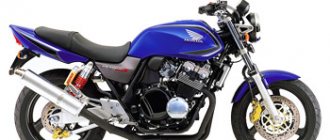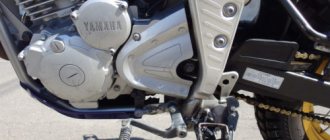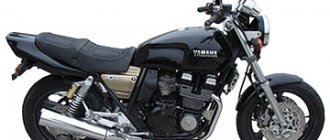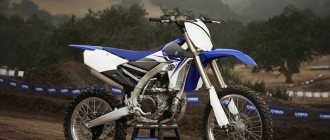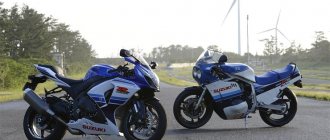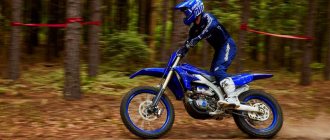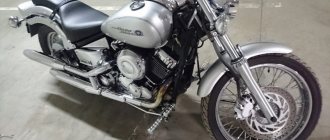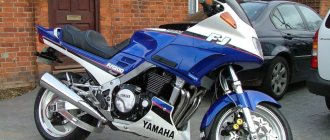| Yamaha YZ250 (1988) (+ steel frame, regular fork) | Yamaha YZ250 (1989~) (+ inverted fork) | Yamaha YZ250 (2005~) (+ aluminum frame) |
| Yamaha YZ250 (2008~) (+ petal rims) | Yamaha YZ250 (2017-2021) (+ front brake disc 250 → 270 mm) | Yamaha YZ250 (2022+) |
| Yamaha YZ250 Monster Energy Yamaha Racing Edition (2022) |
Yamaha YZ250 motocross model
begins its history in 1974 and, unlike cross-country 2-stroke models from other Japanese manufacturers, is still sold in the markets of North America and Europe.
Considering the Yamaha YZ 250 model, it should be noted that the models starting from 2005 are of greatest interest - it was at this time that the motorcycle began to be equipped with an aluminum frame.
The model was based on a single-cylinder 2-stroke liquid-cooled engine with a volume of 249 cm³ and producing 53 hp. power and 49 Nm of torque (data refer to the 2005 model).
In 2006, the Yamaha YZ250 received a new KYB SSS (Speed-Sensitive System) front fork, and in 2008, petal brake discs.
For 2021, the front brake disc diameter increases from 250 to 270 mm.
At the end of 2021, Yamaha introduced the new generation YZ250. The updated version received a new design, improvements to the brake system (lighter, use of stiffer pads, the diameter of the rear brake disc decreased from 245 → 240 mm), intake system and suspension settings.
Other features of the model include an aluminum frame, the presence of a YPVS power valve system (optimize engine performance depending on speed), a carburetor power system (with a throttle position sensor), fully adjustable sports suspension, an 8-liter fuel tank, a 5-speed gearbox and 103 kg curb weight.
At the same time, a version of the Yamaha YZ125 was also produced, which in general had much in common with the YZ250, but was equipped with a smaller engine and a 6-speed gearbox.
In 2021, a hard enduro modification, the Yamaha YZ250X, was built on the basis of the Yamaha YZ250.
The Yamaha YZ 250 model took part in many international motocross competitions, where it invariably took high places:
- 5 AMA National Motocross
- 9 AMA National Supercross
- AMA National Supercross (2004)
- 6-time AMA National Offroad Championships
- EMX300 Championship (2014)
Also in the line of Yamaha motocross motorcycles there is a 4-stroke version - the Yamaha YZ250F.
The main competitors of the Yamaha YZ 250 in the class:
- Honda CR250R (aluminum frame)
- Kawasaki KX 250 (steel frame)
- Suzuki RM 250 (steel frame)
Brief history of the model
- 1974 - Model
: Yamaha YZ250 (USA).
Factory designation
: YZ250A.
- 1975 - Model
: Yamaha YZ250 (USA).
Factory designation
: YZ250B.
- 1979 - Model
: Yamaha YZ250 (USA).
Factory designation
: YZ250F.
- 1980 - Model
: Yamaha YZ250 (USA).
Factory designation
: YZ250G.
- 1981 - Model
: Yamaha YZ250 (USA).
Factory designation
: YZ250H.
- 1982 - Model
: Yamaha YZ250 (USA).
Factory designation
: YZ250J.
- 1983 - Model
: Yamaha YZ250 (USA).
Factory designation
: YZ250K.
- 1984 - Model
: Yamaha YZ250 (USA).
Factory designation
: YZ250L.
- 1985 - Model
: Yamaha YZ250 (USA).
Factory designation
: YZ250N.
- 1986 - Model
: Yamaha YZ250 (USA, Europe).
Factory designation
: YZ250S, 1LU.
- 1987 - Model
: Yamaha YZ250 (USA, Europe).
Factory designation
: YZ250T, 2HH.
- 1988 - Model
: Yamaha YZ250 (USA, Europe).
Factory designation
: YZ250U, 2VM.
- 1989 - Model
: Yamaha YZ250 (North America, Europe).
Factory designation
: YZ250W, 3JE1, 3RB1.
- 1990 - Model
: Yamaha YZ250 (All markets).
Factory designation
: YZ250A, 3SP1, 3SP2, 3SP3, 3SP4.
- 1991 - Model
: Yamaha YZ250 (All markets).
Factory designation
: YZ250B1, 3XK1, 3XK2, 3XK3, 3XK4.
- 1992 - Model
: Yamaha YZ250 (All markets).
Factory designation
: YZ250D1, 4DA1, 4DA2, 4DA3, 4DA4.
- 1993 - Model
: Yamaha YZ250 (All markets).
Factory designation
: YZ250E, 4EW1, 4EW2, 4EW3, 4EW4.
- 1994 - Model
: Yamaha YZ250 (All markets).
Factory designation
: YZ250F1, 4JX1, 4JX2, 4JX3, 4JX4.
- 1995 - Model
: Yamaha YZ250 (All markets).
Factory designation
: YZ250G1, 4MX1, 4MX2, 4MX3, 4MX4.
- 1996 - Model
: Yamaha YZ250 (All markets).
Factory designation
: YZ250H1, 4SR1, 4SR2, 4SR3, 4SR4.
- 1997 - Model
: Yamaha YZ250 (All markets).
Factory designation
: YZ250J1, 4XL1, 4XL2, 4XL3, 4XL4.
- 1998 - Model
: Yamaha YZ250 (All markets).
Factory designation
: YZ250K1, 5DJ1, 5DJ2, 5DJ3, 5DJ4.
- 1999 - Model
: Yamaha YZ250 (All markets).
Factory designation
: YZ250L1, 5CU1, 5CU2, 5CU3, 5CU4.
- 2000 - Model
: Yamaha YZ250 (All markets).
Factory designation
: YZ250M1, 5HC1, 5HC2, 5HC3, 5HC4.
- 2001 - Model
: Yamaha YZ250 (All markets).
Factory designation
: YZ250N1, 5MW1, 5MW2, 5MW3, 5MW4.
- 2002 - Model
: Yamaha YZ250 (All markets).
Factory designation
: YZ250P, 5NX1, 5NX2, 5NX3, 5NX4.
- 2003 - Model
: Yamaha YZ250 (All markets).
Factory designation
: YZ250R, 5UP1, 5UP2, 5UP3, 5UP4.
- 2004 - Model
: Yamaha YZ250 (All markets).
Factory designation
: YZ250S1, 5XF1, 5XF2, 5XF3, 5XF4.
- 2005 - Model
: Yamaha YZ250 (All markets).
Factory designation
: YZ250T1, 1P81, 1P82, 1P83.
- 2006 - Model
: Yamaha YZ250 (All markets).
Factory designation
: YZ250V, 1P85, 1P86, 1P87, 1P88.
- 2007 - Model
: Yamaha YZ250 (All markets).
Factory designation
: YZ250W1, 1P89, 1P8A, 1P8B, 1P8C.
- 2008 - Model
: Yamaha YZ250 (All markets).
Factory designation
: YZ250X1, 1P8D, 1P8E, 1P8F, 1P8G.
- 2009 - Model
: Yamaha YZ250 (All markets).
Factory designation
: YZ250Y, 1P8H, 1P8J, 1P8K, 1P8L.
- 2010 - Model
: Yamaha YZ250 (North America, Europe, Japan).
Factory designation
: YZ250Z, 1P8N, 1P8M, 1P8P.
- 2011 - Model
: Yamaha YZ250 (North America, Europe, Japan).
Factory designation
: YZ250A1, 1P8S, 1P8T, 1P8U.
- 2012 - Model
: Yamaha YZ250 (North America, Europe, Japan).
Factory designation
: YZ250B2, 1SS1, 1SS2, 1SS3.
- 2013 - Model
: Yamaha YZ250 (North America, Europe).
Factory designation
: YZ250D2, 1SS5, 1SS6.
- 2014 - Model
: Yamaha YZ250 (North America, Europe, Japan).
Factory designation
: YZ250E2, 1SS9, 1SSA, 1SSB.
- 2015 - Model
: Yamaha YZ250 (North America, Europe, Japan).
Factory designation
: YZ250F2, 1SSD, 1SSE, 1SSF.
- 2016 - Model
: Yamaha YZ250 (North America, Europe, Japan).
Factory designation
: YZ250G2, 1SSH, 1SSJ, 1SSK.
- 2017 - Model
: Yamaha YZ250 (North America, Europe, Japan).
Factory designation
: YZ250H2, 1SSN, 1SSM, 1SSP.
- 2018 - Model
: Yamaha YZ250 (North America, Europe, Japan).
Factory designation
: YZ250J2, 1SSS, 1SST, 1SSU.
- 2019 - Model
: Yamaha YZ250 (North America, Europe, Japan).
Factory designation
: YZ250K2.
- 2020 - Model
: Yamaha YZ250 (North America, Europe, Japan).
- 2021 - Model
: Yamaha YZ250 (North America, Europe, Japan).
- 2022 - Model
: Yamaha YZ250 (All Markets).
Cons of the Yamaha YZ250
- Yamaha YZ250 chassis. Or rather, its handling is average - nothing particularly good or bad in corners. Without shortcomings and without advantages, which means we write them as cons.
- Yamaha YZ250 engine. It has good traction characteristics, but the Austrian competitor will tear it apart at the start, on the climb or in the sand. Yes, the aftermarket allows you to add more power to the YZ250, but it quickly blurs the $900 line between Yamaha and KTM.
- Transfers. Switching from second to third always occurs with a jerk, but fortunately, in third the engine delivers at any speed, if they are high enough. Ideally, the third would be closer to the second, as on the cross-country YZ250X, but until Yamaha makes a new cross box, all that remains is to add one tooth to the rear sprocket
- Clutch. Many people prefer to install stiffer springs in the YZ250 clutch or alternate the standard springs with them.
Specifications
Yamaha YZ250 (2005+) Specifications:
| Model | Yamaha YZ250 |
| Motorcycle type | cross |
| Year of issue | 1974+ |
| Frame | Aluminum half duplex |
| engine's type | 1-cylinder, 2-stroke |
| Working volume | 249 cm³ |
| Bore/Stroke | 66.4 x 72.0 mm |
| Compression ratio | 8.9~10.6:1 9.2~10.9:1 – YZ250 (before 2015, North America) |
| Cooling | liquid |
| Number of valves per cylinder | reed valve |
| Fuel supply system | Carburetor, 1x Keihin PWK38S |
| Ignition type | CDI |
| Maximum power | 53.0 hp (38.9 kW) at 8000 rpm |
| Maximum torque | 49.0 Nm (5.0 kg-m) at 7500 rpm |
| Clutch | Multi-disc in oil bath, cable drive |
| Transmission | 5-speed |
| type of drive | chain |
| Front tire size | 80/100-21 51M |
| Rear tire size | 110/90-19 62M |
| Front brakes | 1 disc, 250 mm, 2-piston caliper – YZ250 (up to 2017) 1 disc, 270 mm, 2-piston caliper – YZ250 (2017+) |
| Rear brakes | 1 disc, 245 mm, 1-piston caliper 1 disc, 240 mm, 1-piston caliper - 2022+ |
| Front suspension | 48mm inverted fork (fully adjustable), 300mm travel |
| Rear suspension | Pendulum with monoshock absorber (fully adjustable), stroke - 315 mm |
| Motorcycle length | 2184 mm |
| Motorcycle width | 827 mm 825 mm – 2022+ |
| Motorcycle height | 1309 mm 1290 mm – 2022+ |
| Wheelbase | 1481 mm 1446 mm – YZ250 (2015-2021) 1485 mm – YZ250 (2022+) |
| Seat height | 997 mm 976 mm – YZ250 (2015+) |
| Minimum ground clearance (clearance) | 385 mm 367 mm – YZ250 (2015-2021) 360 mm – YZ250 (2022+) |
| Acceleration 0-100 km/h (0-60 mph) | |
| Maximum speed | |
| Gas tank capacity | 8.0 l 7.0 l – 2022+ |
| Motorcycle weight (curb) | 103 kg |
Yamaha YZ250 Chassis and Handling
The main thing about the way the Yamaha YZ250 handles is the lack of any special features. It holds straight lines well and turns well , while it is responsive to steering without sacrificing precision, and the rigidity of its chassis does not cause discomfort. In short, the YZ250 is absolutely predictable, stable and reliable. These specs may sound underwhelming, but there's nothing to get excited about: the 2021 Yamaha YZ250 isn't the nimblest bike, but it's more than capable of winning races.
The 2021 Yamaha YZ250 weighs 99 kilograms—that's quite a bit lighter than the 108-kilogram Yamaha YZ450F, but that's a lot for a 250 two-stroke. KTM won't let you lie: the 250SX weighs 96 kilos.
Reviews
Reviews about Yamaha YZ 250:
How does it compare to TTR? Since, before buying the YZ, I rode a Yamaha TTR for 3 seasons, using it very hard, and also tried similar 250s of friends and acquaintances, I can answer as if I had “eaten oysters”: you simply cannot compare! A cross-country motorcycle is the highest level of evolution compared to any soft enduro developed in the 80s and 90s. In any aspect, the cross-country bike is head and shoulders above the Yamaha TTR, Honda XR, Suzuki DR, Honda CRM, Kawasaki KDX and KLX, etc. The suspension is much better. The motor is much better. Brakes, handling, ergonomics and everything else are an order of magnitude better. The only thing where the cross loses is in resources. And, again, the resource includes everything - the engine, suspension, brakes, etc.
Are there enough “lower classes” after the 4-stroke? After a year of hard use in various conditions, I only experienced a lack of smooth power build-up in particularly difficult conditions. For example, at the enduro stage of the CR there was a section with a slight uphill climb, after a short ford through a mud ditch, with protruding tree roots, stones and liquid mixed soil. It was hard there, yes.
All other moments when you need to move slowly “at idle” are solved very organically and without problems by priming the clutch. In general, the acceleration speed of a two-stroke engine turns the clutch into a powerful weapon that you need to know how to use. On 4T it’s the same, but the effect is less noticeable.
And one more thing - you need to learn how to use the clutch! Without this skill there will be no progress in riding either 4T or 2T!
How does an aluminum frame feel? After an aluminum frame, all motorcycles with an iron frame seem soft and “wobbly”. There is no feeling of monolithicity of the motorcycle, clarity of following a given trajectory. But on the other hand, it’s really easier to ride on a shaking surface - it doesn’t tear your hands off and doesn’t hit your butt.
Yamaha YZ250 Suspensions
Back in 2006, Kayaba SSS suspensions were far ahead of the competition: the SSS fork has excellent flat-out resistance and well-designed smoothing. This is arguably the best stock fork available today, and the new generation of spring forks on the Suzuki RM-Z450, Honda CRF450 and Kawasaki KX250 do not compare to the SSS.
Why is she so good? It was designed so that at the beginning of the stroke it had a more rigid smoothing and quickly returned to its original state in order to be ready for a new obstacle. Previously, the smoothing pattern of the average motocross fork was 70 percent dependent on the position of the fork piston in the cartridge: the further the piston went down, the harsher the smoothing.
In a stroke of genius, Kayaba made the 2006 SSS fork 90% speed dependent. Speed-dependent smoothing is so called because the stiffness of the smoothing does not depend on the position of the fork piston in the cartridge, but on the speed at which the piston moves across the cartridge. By moving from 30 percent speed-dependent to 90 percent, Yamaha found the perfect approach to suspension: all subsequent Yamaha forks from 2006 to 2021 are based on these developments and have similar linearity smoothing. There are no peaks or valleys in their characteristics; they change stiffness equally at the beginning of the stroke and at the end depending on the speed. Now it's easy to say that the stiffness of modern forks is dependent on speed, but that's the same as saying that all modern forks are copying the Kayaba SSS idea.
Yamaha YZ250X engine
The base YZ250 engine has been at the forefront of its class for over a decade. The Yamaha YZ250X uses almost all the same components as the motocross version, but the differences include a different compression ratio, a different exhaust port and the use of the YPVS (Yamaha Power Valve System). All of these differences are aimed at achieving controlled, broad-range power for XC and Enduro racing. On forest paths, the Yamaha YZ250X behaves like a classic two-stroke motorcycle, picking up well from the mid-range of revs to the very top , but transmitting this power noticeably more smoothly in comparison with the motocross version of the motorcycle. He could realize the torque at even lower revs, but this would negatively affect the motorcycle's grip.
Yamaha YZ250X engine
The Yamaha YZ250X also has a wider range of transmissions. Our experience is that the bike has taller third, fourth and fifth gears, with first and second gears comparable to the YZ250. The stock transmission setup is quite good with close first three gears for enduro racing. The fourth and fifth gears have become slightly longer, which has a positive effect on driving sections. If you plan to ride this bike over long distances and/or in desert races, you may need the extra speed. This can be achieved quite easily by setting the driven sprocket to one or two smaller teeth. The clutch is quite soft and responds very well, and a slight pull on the clutch lever allows you to spin the engine quite quickly.
SURVIVAL FITTEST: YAMAHA YZ250 2-Blizzard STORY
1974 YZ250A
History of the Yamaha YZ250 is the History of motocross in America. No other car has been the platform for so many amazing innovations. The list of innovations goes on and on: reed valves, single-shock suspension and power valves all started with Yamaha. There's no telling what motocross history would look like if it weren't for the YZ250 and the people behind it. But it will certainly be very, very different. On top of that, YZ has one very important last thing on his resume. Today it is the last 250cc two-stroke engine. See from Japan. That makes it the longest-running production SUV in the world—perhaps even the longest-running motorcycle model of any kind outside of Milwaukee and Russia.
Canadian monoshock 1975 YZ250
Perhaps more than anything else, the YZ250 is famous for the legendary racers who used it to win. The list includes Gary Jones, Bob Hannah, Mike Bell, Ricky Johnson and Jeremy McGrath, to name a few Americans. In Europe, Hakan Andersson, Hakan Carlqvist and even Danny Laporte gave YZ their early championships.
1979 YZ250
RECORDS Perhaps one of the reasons the YZ is so indelibly intertwined with American motocross history is because it was developed here. The very first YZ didn't appear in a well-lit research and development room at a Japanese factory. It was built in Southern California by Don Jones for his son Gary. Yamaha allowed the Jones clan to run the existing DT-1 two-stroke engine. The resulting bike won the first AMA motocross championship, then was shipped back to Japan to become the first production YZ. Jones won two titles for Yamaha, the first of which came from the Inter-Am series. Meanwhile, the Monoshock rear suspension system was being developed in Europe by Hakan Andersson, who used it to win the 1973 250 World Championship. For a detailed account of this story, see www.mxworksbike.com.
1980 YZ250
Pierre Karsmaekers won the first Supercross series for Yamaha in 1974, but the next American YZ250 champion didn't emerge until 1977 when Bob Hannah moved up to the 250 class and dominated motocross for the next three years. During that time, he won three Supercross titles, two outdoor championships and a 22-runner winning streak. This was, of course, at the height of the bike era, when factories were spending hundreds of thousands on exotic factory bikes. But during this period, Yamaha made a bet on production-based racing motorcycles, both with Hannah and later with Rick Johnson.
1982 YZ250
After Hannah broke her leg late in the 1979 season, Mike Bell won his lone Supercross title in 1980, Brock Glover occasionally raced and won on the 250, although he was more closely associated with the YZ125 and YZ490. Rick Johnson's success was legendary, but his early years were with Yamaha and the YZ250. His departure left a void that wasn't filled until Damon Bradshaw showed up. The most amazing thing about Bradshaw's career was his ability to not win championships despite winning races. He still ranks 11th on the overall Supercross wins list, but does not have a single national title.
1985 YZ250
Jeremy McGrath is probably best known for his years at Honda, but he won Supercross titles in 1998, 1999 and 2000 on a YZ250. At the time, his closest rival was fellow Yamaha YZ250 racer David Vujemin. The last national motocross championship that YZ received was the 2004 Supercross title with Chad Reed.
OFF-ROAD The Yamaha YZ250 has been and remains a bike that is highly regarded by both motocross and off-road riders. In fact, no other bike has proven so capable in
1987 YZ250
both worlds. He won three GNCC championships with Ed Lojak, Fed Andrews and Barry Hawk. He won two National Enduro titles with Randy Hawkins and Ty Davis; three WORCS championships featuring Davis and Nate Woods; seven national hare wrestling championships with Jason Raines and Doug Blackwell, and he even contributed to a national hare and hound title with Ty Davis, who competed in the 250 in select events. If you go strictly by the numbers, the YZ is more of an off-road bike than a motocrosser. He has 15 off-road championships and only 14 motocross titles. Add them all up and the YZ is the winner of the cross-platform racer in America. 1968 : Yamaha introduced the DT-1 250 two-stroke and everything changed. Before this, no one would have thought about racing a Japanese bike professionally. Although this first model was not a racer, it became a platform for various racers because it was lightweight and reliable. European motorcycles would still rule, but their days were numbered.
1988 YZ250
1974: The first YZ250A was introduced. It was based on the bike that Gary Jones used to win the 1971 National Championship, which was actually derived from his Top American status in the Inter-Am Series. According to legend, Don Jones shipped the bike to Japan with "A2Z" written on it, signifying that everything on it had been changed from A to Z. Jones made a new frame, cast his own engine cases and strapped CZ alloy fuel. tank with wedding potholder. When the bike arrived, it was renamed the YZ because all Yamahas started with a Y. But it was surprisingly true to what Jones had built, right down to the strap on the tank.
1975 : Another Yamaha development program took place on the European front with Hakan Andersson. Andersson started the 1973 season with a works version of the YZ called OWXX. But at the third race in Belgium he debuted the OWXX Monoshock and won. This bike, in turn, was the basis for the 1975 YZ250B and its Monoshock rear end. It was the best bike of its time, but things were changing so quickly that it was completely redesigned the following year. 1976 Before this, Yamaha had two lines of motorcycles: the YZs and the lower-priced MXs. In 1976, both were merged. More precisely, the MX250 suddenly had the YZ logo painted on the gas tank and the price was increased. This was a corporate cost-cutting measure. Purists mourned the loss of the ultra-light YZ250, which was essentially a work bike. In truth, the 1976 version performed just as well as its predecessor despite the extra weight, but the Europeans were catching up and Suzuki came out with their bombshell RM250. This was the year of the fork cans that looked like a speedometer and a wheelbarrow.
1989 YZ250
1977 : Yamaha made a quick comeback. A completely new motorcycle was launched with a very small motor, lighter frame and more travel. The fuel tank was plastic and the swingarm was steel. 1978 Model looked almost identical, but had more travel and an aluminum swingarm. At this time, Bob Hannah was in the middle of his winning streak, and after each race Yamaha would raffle off its production bike to the public. 1979 : This was a standalone year for the YZ250. The 1979 model had a different look and an engine that was abandoned after a year.
1980 : To this day, YZ250s from this period are highly prized and sought after. Suspension and power were excellent, and the 1980 model was almost identical to the 1981 version, with the exception of the transmission, which switched from six speeds to five speeds. 1982 Everything changed, and not necessarily in a good way. The 1982 YZ250 was a technological milestone. It was liquid cooled with a radiator mounted on the forks. It received the first production power valve and received a link between the swingarm and the shock absorber. Almost all of these measures were ineffective and were reworked later. The radiator placement had a bad effect on handling, the shock was closed where there was no airflow, and the power valve was located so far from the piston that it had little effect. 1983 Yamaha began to smooth out the previous year's design. The radiators were moved to the frame and the shock was moved halfway up the swingarm. These small changes continued through 1984 and 1985, but Yamaha was dipping pretty deep into snake oil with features like the shock-mounted BASS valve and Boost Bottle. Last year the yellow and black color scheme disappeared, and from then on the American models became white, like their European counterparts.
1991 YZ250
1986 This was another complete redesign. The '86 Yamaha received new chassis and body work, and most of the engine's internal parts were massaged. The front brake was hydraulic. The most important of all the changes was the relocation of the rear shock absorber. From now on, the Monoshock rear suspension will be called motocross, but it will be essentially the same as Honda, Suzuki or Kawasaki. The advantage of having the first rear shock absorber was long forgotten. After this there was a long period of minor changes. The years of complete modernization were over. But the engine received a huge boost in 1987 and another set of bodywork in 1988 .
1992 Yamaha WR250 off-road
1989 : The Kayaba fork was reversed, leading to years of controversy. To this day, many insist that the old style fork with an inner tube on top was the better design. Doesn't matter; the inverted fork would remain, although it would be a significant improvement over its '89 debut. Over the next few years, Yamaha made significant changes to the YZ's appearance. It got new heads in '93 and went purple in '94 . But the biggest change was a new top in 1995 with a new power valve that looked like a huge tumor on the side of the motor. During these years, Yamaha was losing to Honda in the horsepower war, but making steady gains in the suspension department. During this period, Yamaha also offered the WR250, a rod-mounted version of the YZ. 1996 : Everything except the engine changed in 1996. The frame has been redesigned, and between the new body and new color, the YZ has a new personality. The annual color changes have ceased and from now on the Yamaha will be referred to as a blue bike. The engine, however, was still a weak point.
2013 YZ250
1999 : Yamaha finally tired of the post in '99. The old motor was completely discarded. The YZ's powerplant hasn't received this much attention since 1992, and it probably hasn't received this much improvement ever. The motorcycle's throttle response and fun are greatly enhanced. Over the next few years, Yamaha improved the engine in small ways, but today it remains virtually unchanged. 2002 : The YZ frame was next on the hit list. The chassis received a remake in 2002 with a slimmer body and a new airbox. By this time, more and more development resources were being directed toward four-stroke projects. 2005 : Yamaha gave the YZ250 one last gift before turning out the lights on the two-stroke R&D department. The YZ has an aluminum frame. It's interesting to note that Yamaha has been testing aluminum as a frame material for a long time - even going back to the 1997 Honda CR250R. When aluminum finally came to the entire YZ line, Yamaha used a conventional trunk layout instead of a perimeter design. The test riders did their best to make the new frame handle look like the old one. Yamaha has since moved to a four-stroke engine layout around the perimeter, but the YZ250 and 125 frames remain unchanged. For 2015 , Yamaha gave both the YZ250 and 125 new looks and revised suspension.
2014: After several years of minor changes, mostly as a result of improvised four-stroke developments, Yamaha has reopened the YZ250's cold case file. They ran the numbers and decided that a new body was warranted. So the YZ gets a facelift along with suspension changes.
2017 Yamaha YZ250X
2016: Realizing that most of the new YZ250s were used as playbikes, Yamaha released an off-road version of the motorcycle. The YZ250X gets a kickstand, wide-ratio transmission, remapped ignition and a more compact pipe. The suspension has also been changed for off-road use. The YZ motocross version was still in the pipeline. STILL ONE Yamaha lives on today, but its future is unclear. It still sells enough to justify its place in the lineup, but even four-stroke sales aren't very impressive these days. There has been talk of a new Yamaha two-stroke in the wind, but time will tell. If any bike deserves to carry the two-stroke flag into the future, it's the YZ.
To read about the Yamaha YZ125, click here.
Dimensions and weight
If we talk about weight, then the motorcycle filled with all the necessary ingredients (1 liter of oil + 6 liters of fuel) is only 106 kg. Net weight less than 100 kg.
A tenacious and powerful “crossover”, which has collected many positive qualities from its predecessors.
The model is designed taking into account athletes of tall and medium height. Short stature may cause some difficulty in placing your feet on the ground.
- Length - 2162 mm.
- Width - 828 mm.
- Height - 1307 (total), 900 (at the saddle) mm.
- Base - 1469 mm.
- Ground clearance - 375 mm.
